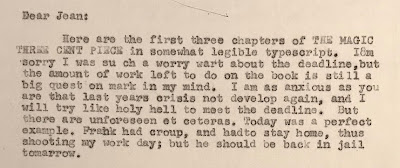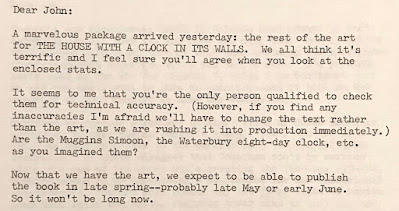The House With A Clock In Its Walls was published in the summer of 1973 and was a success for author John Bellairs and Dial Publishing. The publisher was eager for a second book from the author and Mr. Bellairs was busy writing two manuscripts for consideration, the first being a sequel to House and the other a stand alone story for teens. The success of House meant that the stand alone story eventually was set aside and The Figure In The Shadows, which was intended as the central book in The Lewis Trilogy, became the priority project. Anxious to repeat the success of the first book, Dial retained Edward Gorey to illustrate this title.
A Halloween deadline was agreed upon for the author to submit a completed manuscript. A letter dated September 23, 1973 to the editor begins:
The June 14th report from Dial:
John Bellairs reply a few weeks later:
Victoria Chess did submit examples of her work for consideration, but Dial was not overly enthusiastic with her samples. This, coupled with the fact that Ms. Chess was currently living in Lebanon which would have complicated the logistics, eliminated her from the project. By the end of September illustrator Mercer Mayer was engaged to illustrate Figure.
Why didn't Edward Gorey come through with the illustrations for this book? While there is no first hand explanation in the Bellairs Archive, there are several factors that would have certainly influenced his decision to withdraw from the project.
1973 had been an exceptionally prolific year for Edward Gorey wherein he published six of his own books, completed illustration projects for other authors, wrote movie reviews for The Soho Weekly News, and designed the sets and costumes for a production of Dracula in Nantucket that would move to Broadway in 1977 on the strength of his designs.
A large portion of Edward Gorey's time and energy in 1974 was taken up with two major exhibitions of his work. The Graham Gallery in New York City exhibited new works by Edward Gorey, showing forty-six pieces created expressly for the show. This was Mr. Gorey's first fine art gallery show. He would participate in only two other gallery shows of his art (also at Graham), but these shows would feature far fewer new works and be filled in with art he created for his books.
Mr. Gorey also agreed to the first major retrospective exhibition of his works. The exhibition was titled Phantasmagorey and was mounted at Yale University.
All of these factors came together making 1974 a year where Edward Gorey did not publish a book of his own* and he took on very few illustration projects. Some illustration projects fell to the wayside and The Figure In The Shadows was one of those projects.
*CATEGOR Y has a publication date of 1974, but only due to printing/binding delays. All of the prep work for this title was completed in 1973.
























